Roni
Member
Hi,
The previous trip report part:
India 2012 - 5: The present Glory of Agra Fort (50 p.)
http://railroadforums.com/forum/showthread.php?t=39709
The accompanying video:
http://www.youtube.com/watch?v=Ln9ntoVBVts&hd=1
February 7 2012
I arrived in darkness before time at Jodhpur, that's why I want to show a few pictures from the next morning (February 8 2012) at the main station of the second largest city in Rajasthan - known as the Blue City. These photos were taken with the small Powershot, as I was filming at the same time.
Old station signs reminding of the London tube.

A class WDM-2, THE Indian diesel loco class, from 1962 thousands of these ALCO derivates were built by Diesel Loco Works at Varanasi, steadily improved but still based on 1950s technology. 16792 from Abu Road shed was just departing hauling its express.

Only in 1999 (class WDG-4, GT46MAC) and 2001 as passenger version (class WDP-4, GT46PAC) completely new models designed by former GM EMD were introduced. Again they are mass produced, at Bhagat Ki Kothi (BGKT) shed, situated only one station south within Jodhpur city limits, already a mighty fleet is based as you can see with this little parade. We already know 40038 from Agra Fort - India is small... errrrm large!

That way you know if you caught the right train: passenger lists are attached to each reserved long distance coach, of course the same can be looked up online.


The express had left the platform, vendors with carts could now move on.

Sleeper coach S2 of the two hours delayed 19224 Jammu Tawi - Ahmedabad Express, the first two digits of the coach number indicate that it had been put into service in 2003.

These coaches transported on broad gauge were built in 1990, now renewed for the sadly disappearing metre gauge network.

Brushing teeth outside according to my observations is an Indian hobby, fine by me, as I like to wander around while brushing as well...

Now we leave the main station and return to February 7 2012.
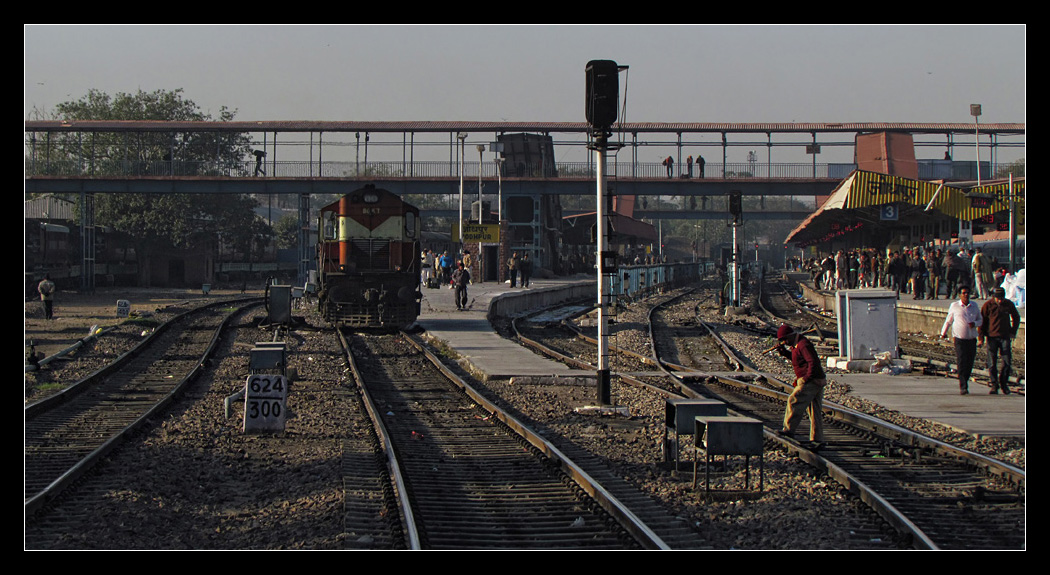
After arrival at Jodhpur I immediately took a tuk-tuk through the cold Rajasthan night, the driver was wrapped in very warm clothes. First I had to wait in front of the gate at the hotel with garden and could not spot anyone inside. After a short wait someone noticed me and I even could already occupy my room. It was very large and decorated in "heritage" hotel fashion. Not everything had been freshly renovated, but overall good value for just 1000 rupees per night. I lied down a little and then visited the first northeastbound station within Jodhpur, Raika Bag Palace Junction. Here, the line to Jaisalmer through Thar desert was branching away from the line to Bikaner. On the way my tuk-tuk was slowed down by a street sweeping welfare campaign attended by busloads of people. I walked into the station and immediately saw - excellent, the semaphores were still standing, and not too few. After a quick visit to the station manager I got the OK with my photo permit, then the first WDM-2 was already rolling into platform 1. Some low stratus still was blocking the sun a little but would dissolve soon - promised, for the following 2 1/2 weeks it will be 100% sunshine!
Renewed Itarsi WDM-3A 16485 far away from its home pulling the 54812 Jodhpur - Bhopal passenger, a local about to manage a route of 993 km in 26:45 hours.
Originally the rebuilt class had not been named WDM-3A but WDM-2C, but it was later decided to classify according to horsepower (WDM-2: 2600, WDM-3A: 3100).

Clear signal for the mainline straight ahead, to the left the line towards Jaisalmer.


The 19224 Jammu Tawi - Ahmedabad Express was hauled by Abu Road WDM-2A ("A" - retrofitted with airbrakes) 16582 that day also stopping at this Jodhpur suburban station about 2 1/2 hours late. Overall you often get surprised by trains not included in your planning in India, it is advisable to always take photos of the train running plates for later reconstruction of events.
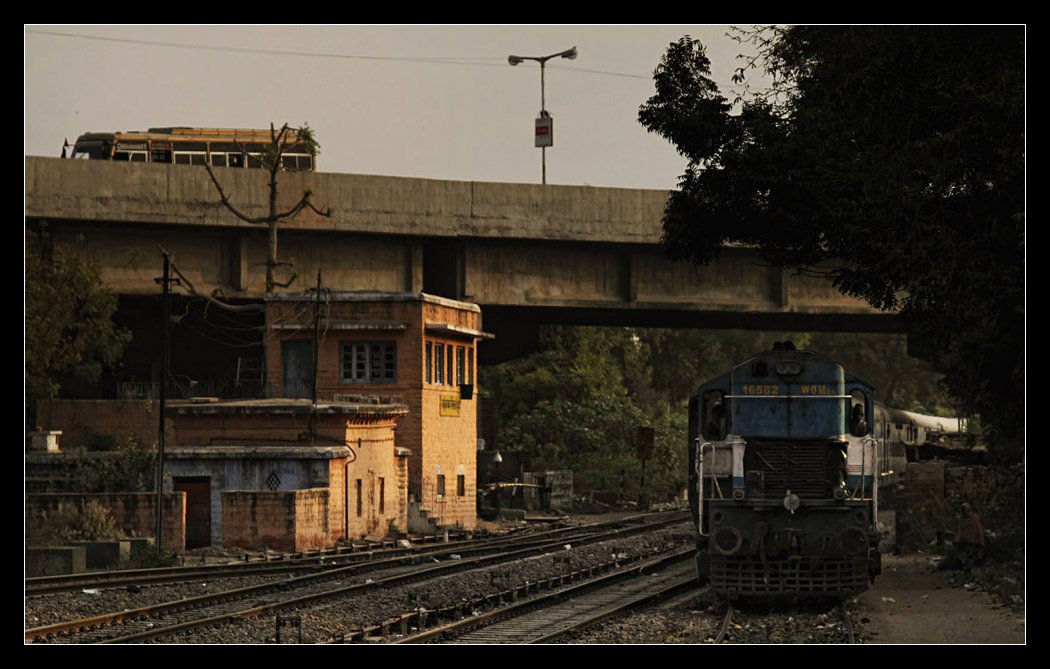

Soon a few express- and passenger trains were rolling by, including the Jodhpur Jaisalmer passenger which I would take the next day. More about it in the following trip report part.

Already a lot of blue to be seen in the Blue City!

The only time on the whole trip I was asked for a portrait by women...
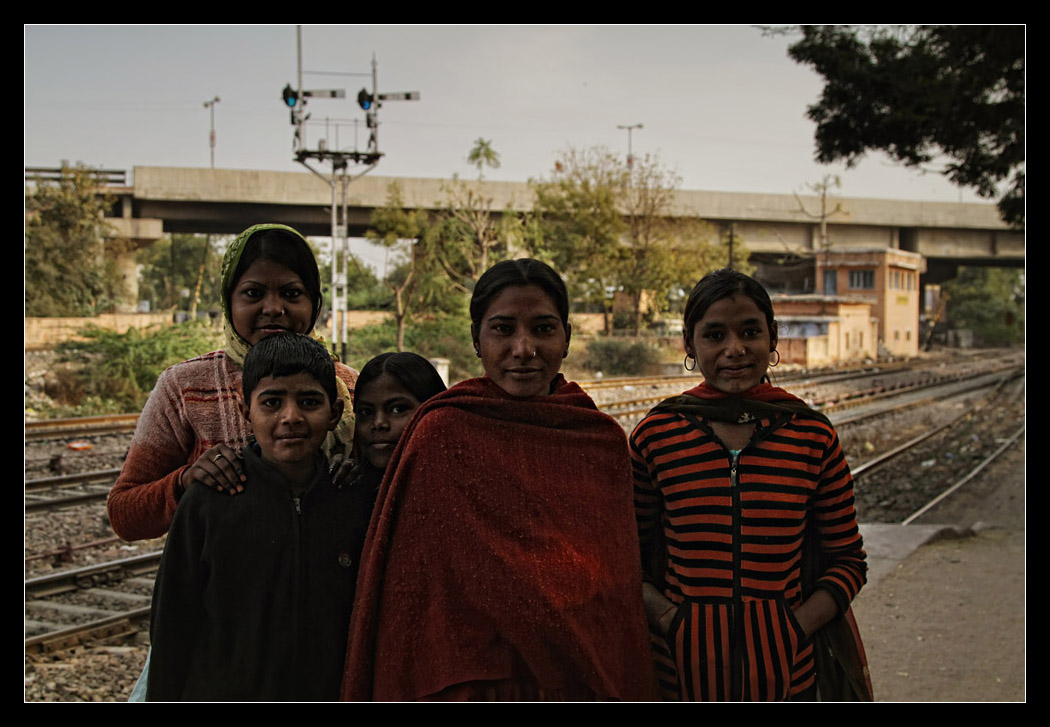
Morning express travellers, a cow completed the scenery.

In the background BGKT WDG-4 12305 approached with a freight and came to a halt.

22482 Delhi Sarai Rohilla - Jodhpur Superfast followed, pulled by BGKT WDM-3A 16003.
In 2010 the classic 4 digit train numbers were replaced by a five digit system. First digits mean for example the following: 1 - express, 2 - also express, if they ran out of 1s, 5 - local, 6 - mainline EMU, 9 - Mumbai suburban train.

The distant signal still was at danger as the Superfast passed by slowing down, then finally the line became clear, the driver happy - but suddenly: Squeak! An impatient inhabitant of Raika Bag had pulled the emergency cord and forced an impromptu suburban stop. The offer to save the miles to the main station and back was happily accepted by a crowd of people - on a mainline passing track!
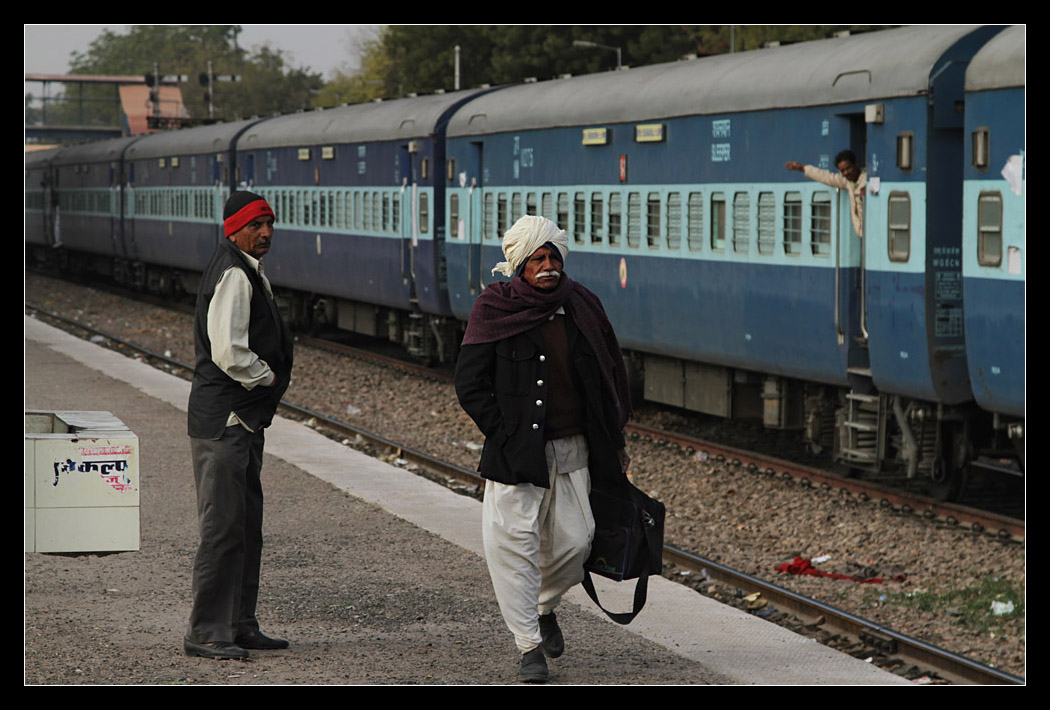
At last the ALCO could accelerate again spewing black smoke.

A few late deciders jumped off at the last moment.

Exotic birds? - Nope.

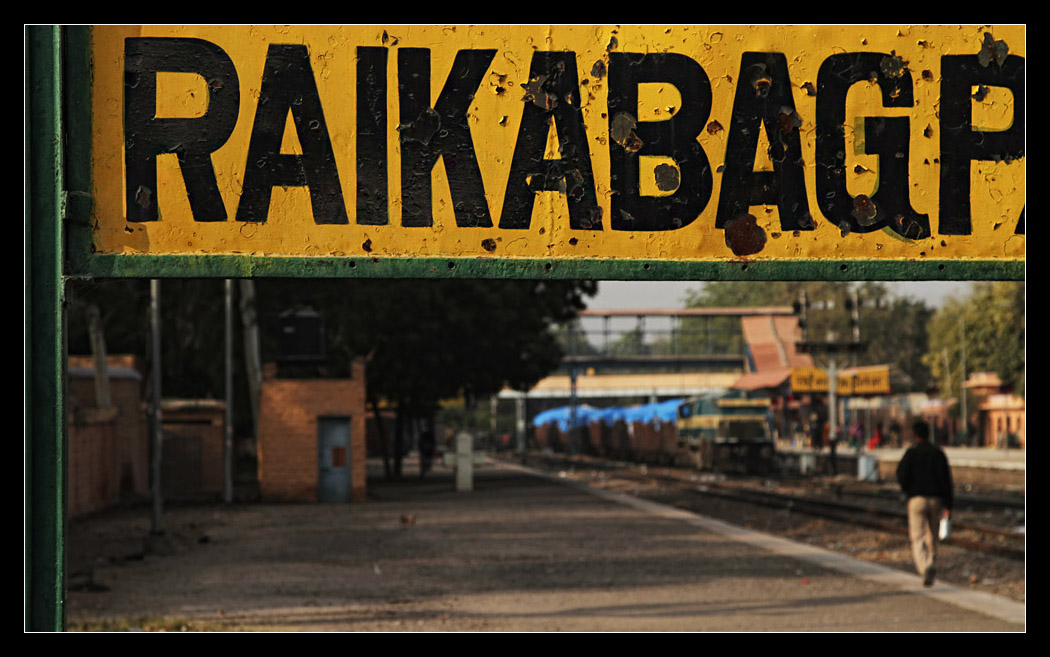
Being built industriously this is the class WDG-4 model with serial number 292 and by far not the most recent.

From the other direction BGKT WDG-4 12474 approached with a load of well-known globalized containers.

WDG-4-meeting with Hapag-Lloyd.

Of course the train now blocked from sight departed emitting a GM roar familiar to me, even if it was a more modern version of the engine than in former Yugoslavia.
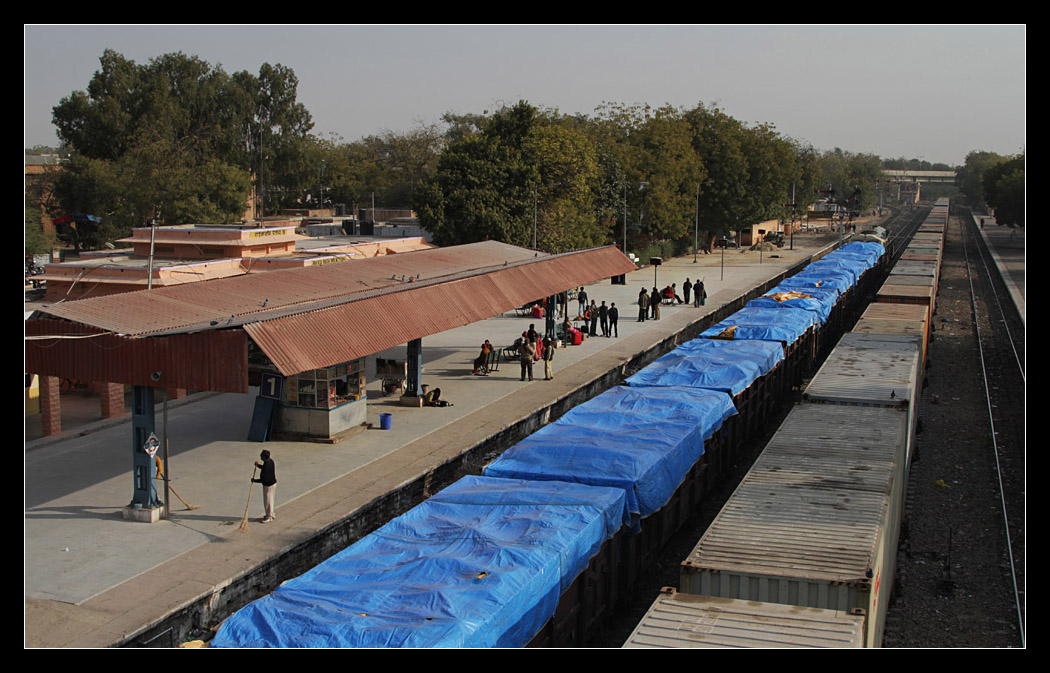
Hmmm, quite a lot of blue here - maybe that is the reason why it is called the Blue City?

Before leaving I stopped by the station master's office. He wanted to have a copy of the photo permit, and I also presented him a photo of an Austrian Federal Railways station master. Of course all guys had to pose for pictures, some in fictional action. The station master insisted on putting on his tie first being joshed for that by the others.

Notice the "industrial computer".


Next I paid the main station another visit to get a last new reservation at the remote reservation centre accessible through a back street. Meanwhile I had received an e-mail with all Indrail Pass reservations information so it was no longer necessary to queue at ticket counters.
In front of the station this treasure could be admired, narrow gauge steamer ZB 120. The only problem was that it had absolutely nothing to do with Jodhpur as this area never saw a 760 mm line.

760 mm? That reminds us of something...
Sadly some errors had occured during renovation of the loco by Bhagat Ki Kothi shed, to be exact only the word "Brod" had been spelled correctly.

A late morning break at the platform.
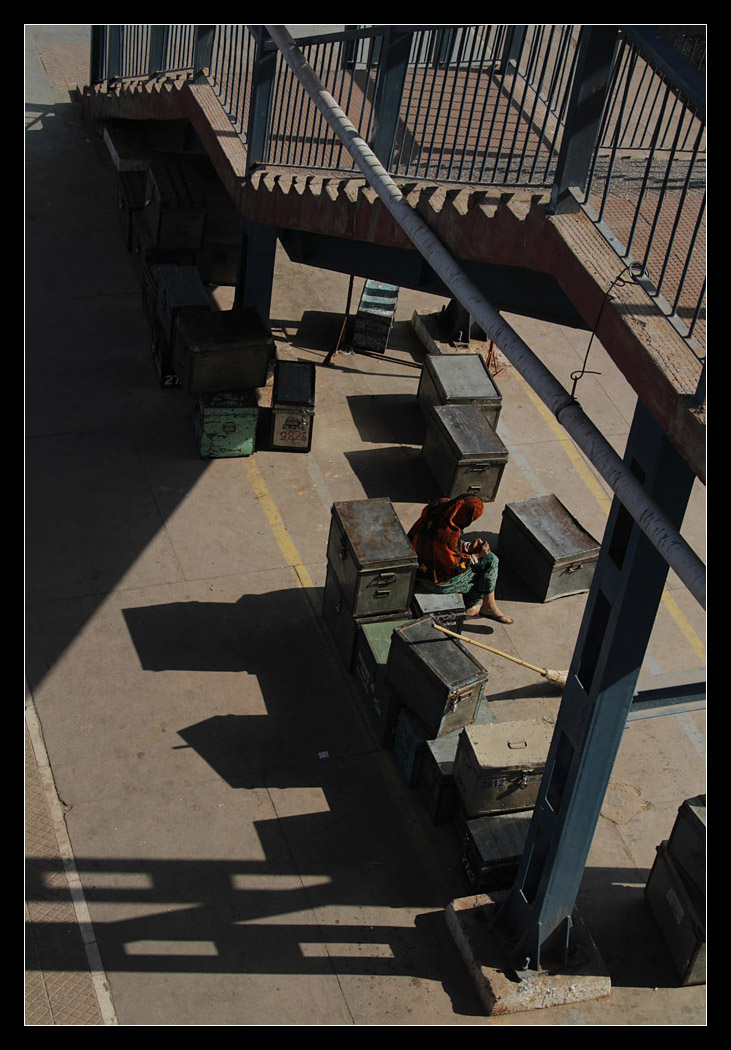
Busy southwest station exit.

The station clocktower was overtopped by mighty Meherangarh Fort which we will visit later.

Predominating colour blue!


Sweeping on...
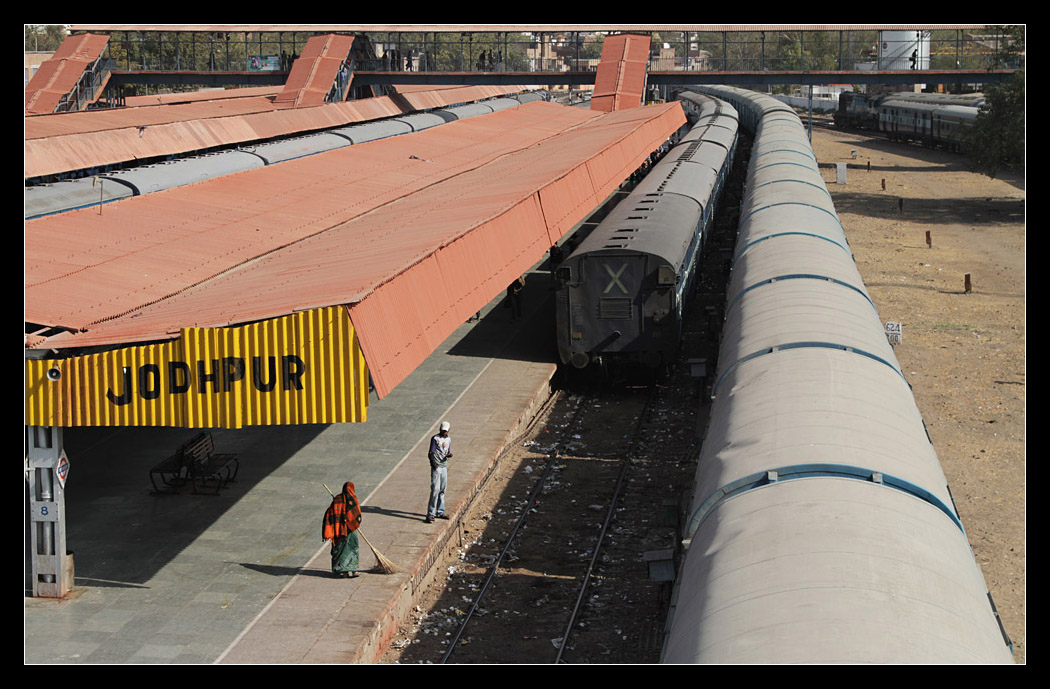
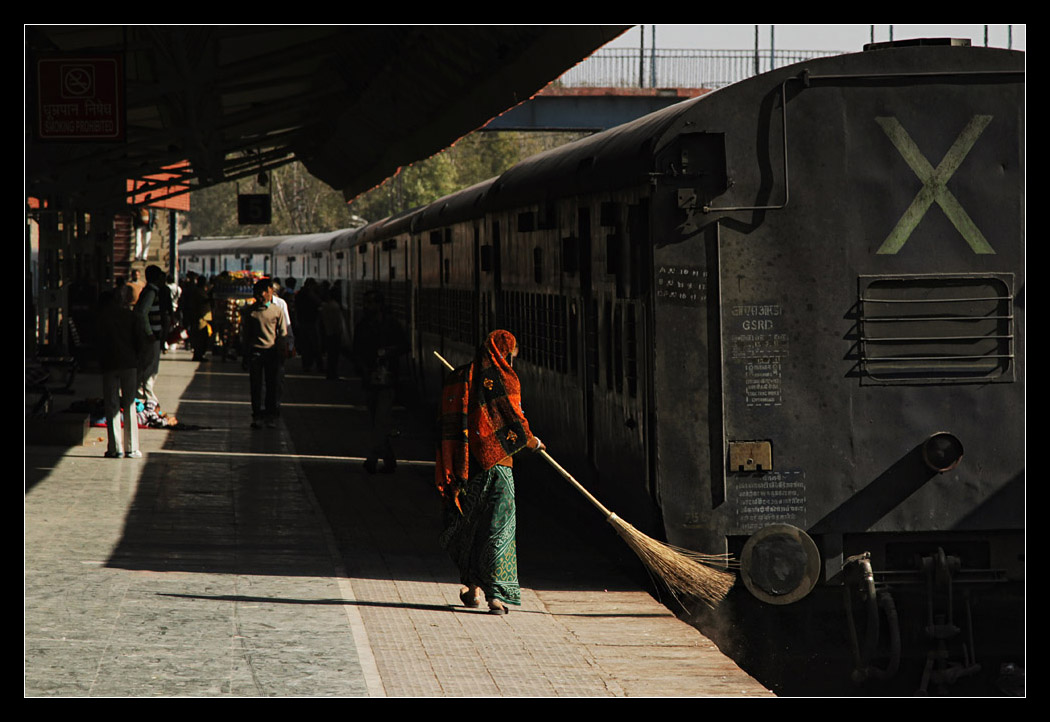
BGKT WDM-2 17725 shunting on the stabling lines. You clearly can recognize AC coaches by the roof configuration.

This is the reason why IR fans call Jodhpur the Blue City!
Fine, a military ACII coach was also included...

Until noon I rested again and later took lunch at the hotel, excellent chicken curry even though they had to fire up the kitchen especially for me as only guest.
In the afternoon the fort was waiting, but first this tuk-tuk needed minor repairs. The engine was located right under the driver's seat, probably so you can immediately feel overheating...
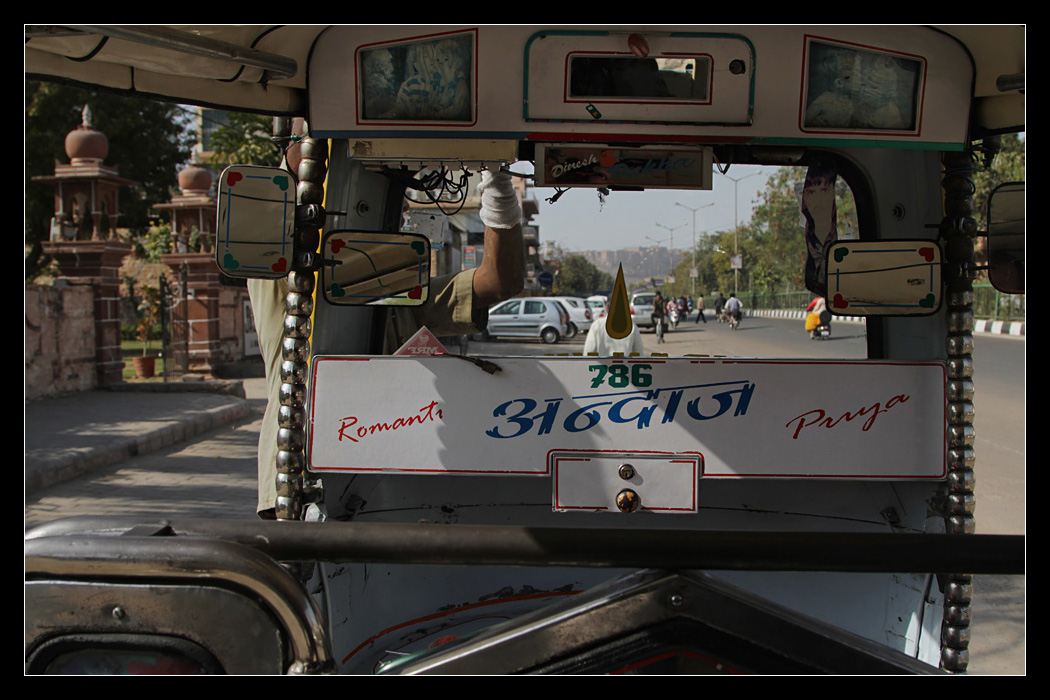
Riding through the very busy town.

On serpentines the climb to the fort was steep, my tuk-tuk struggled but made it!
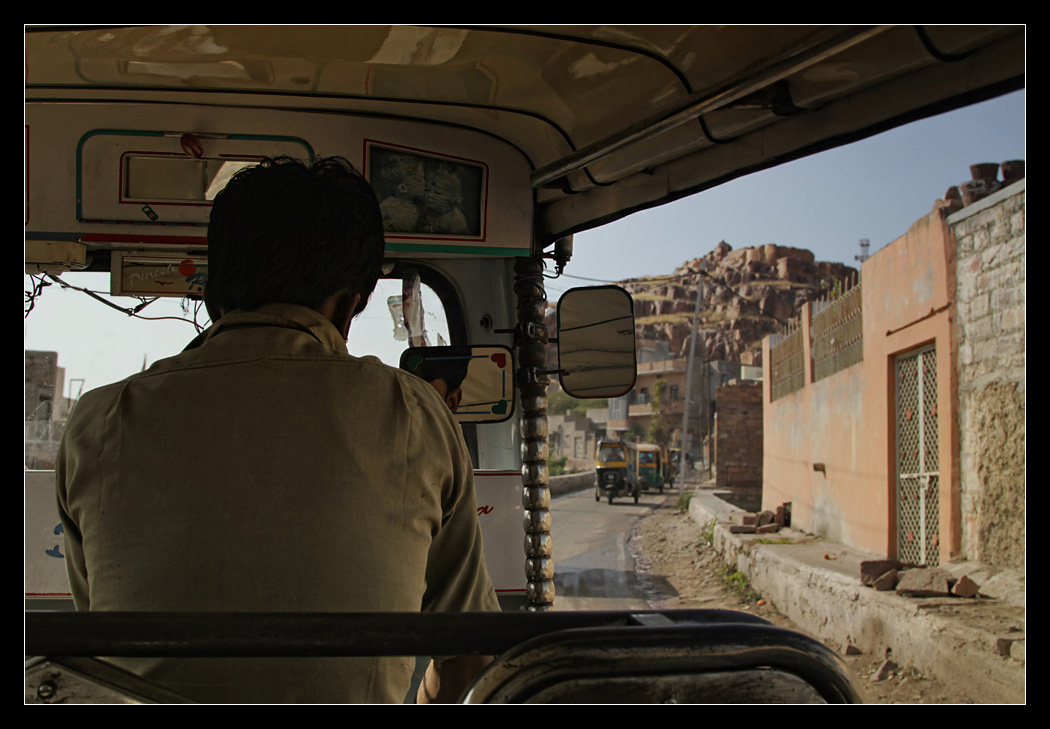
Typical town houses.
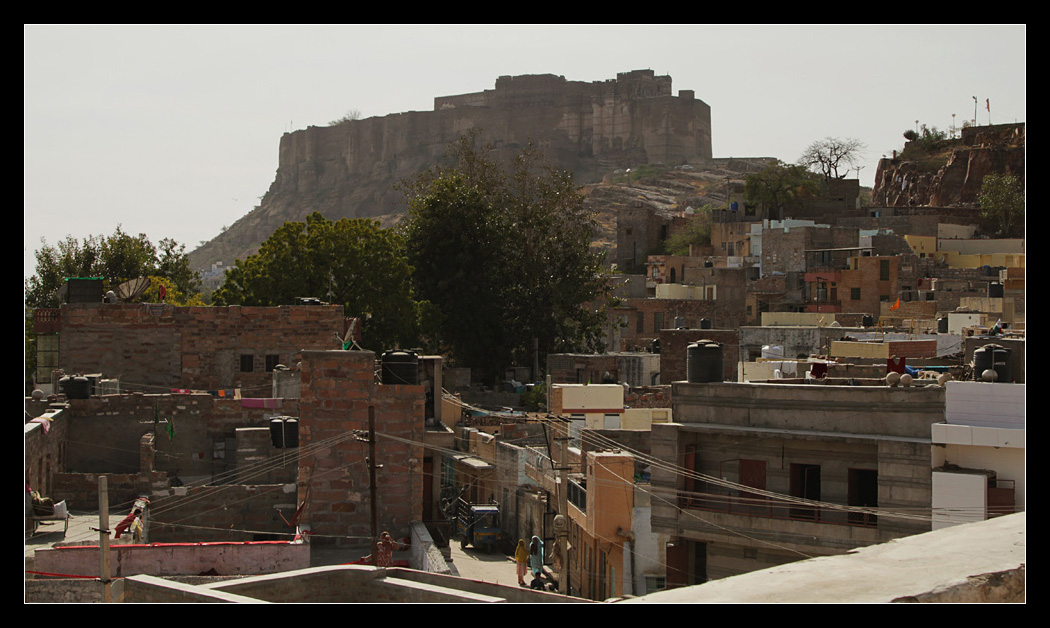
OK, having arrived at the top I have to admit that large parts of the old Jodhpur city centre actually had been painted blue. Originally only Brahmans were allowed to do it, but now it has become a custom for most owners of town heritage buildings called havelis.

In the next travelogue we will explore this breathtaking palace and later take a trainride into the desert!
The previous trip report part:
India 2012 - 5: The present Glory of Agra Fort (50 p.)
http://railroadforums.com/forum/showthread.php?t=39709
The accompanying video:
http://www.youtube.com/watch?v=Ln9ntoVBVts&hd=1
February 7 2012
Code:
12307 HWH JU EXPRESS
...
18 AF Agra Fort 19:50 20:10 20 NCR 1260 2
19 AH Achhnera Jn 20:40 20:42 2 NCR 1286 2
20 BTE Bharatpur 21:14 21:16 2 WCR 1314 2
21 JP Jaipur Jn 00:05 00:15 10 NWR 1501 3
22 KMNC Kuchaman City 01:48 01:49 1 NWR 1606 3
23 MKN Makrana Jn 02:05 02:06 1 NWR 1620 3
24 DNA Degana Jn 02:55 02:56 1 NWR 1664 3
25 MTD Merta Road Jn 03:32 04:00 28 NWR 1709 3
26 JU Jodhpur Jn 06:00 Last Stn NWR 1813 3I arrived in darkness before time at Jodhpur, that's why I want to show a few pictures from the next morning (February 8 2012) at the main station of the second largest city in Rajasthan - known as the Blue City. These photos were taken with the small Powershot, as I was filming at the same time.
Old station signs reminding of the London tube.

A class WDM-2, THE Indian diesel loco class, from 1962 thousands of these ALCO derivates were built by Diesel Loco Works at Varanasi, steadily improved but still based on 1950s technology. 16792 from Abu Road shed was just departing hauling its express.

Only in 1999 (class WDG-4, GT46MAC) and 2001 as passenger version (class WDP-4, GT46PAC) completely new models designed by former GM EMD were introduced. Again they are mass produced, at Bhagat Ki Kothi (BGKT) shed, situated only one station south within Jodhpur city limits, already a mighty fleet is based as you can see with this little parade. We already know 40038 from Agra Fort - India is small... errrrm large!

That way you know if you caught the right train: passenger lists are attached to each reserved long distance coach, of course the same can be looked up online.


The express had left the platform, vendors with carts could now move on.

Sleeper coach S2 of the two hours delayed 19224 Jammu Tawi - Ahmedabad Express, the first two digits of the coach number indicate that it had been put into service in 2003.

These coaches transported on broad gauge were built in 1990, now renewed for the sadly disappearing metre gauge network.

Brushing teeth outside according to my observations is an Indian hobby, fine by me, as I like to wander around while brushing as well...

Now we leave the main station and return to February 7 2012.

After arrival at Jodhpur I immediately took a tuk-tuk through the cold Rajasthan night, the driver was wrapped in very warm clothes. First I had to wait in front of the gate at the hotel with garden and could not spot anyone inside. After a short wait someone noticed me and I even could already occupy my room. It was very large and decorated in "heritage" hotel fashion. Not everything had been freshly renovated, but overall good value for just 1000 rupees per night. I lied down a little and then visited the first northeastbound station within Jodhpur, Raika Bag Palace Junction. Here, the line to Jaisalmer through Thar desert was branching away from the line to Bikaner. On the way my tuk-tuk was slowed down by a street sweeping welfare campaign attended by busloads of people. I walked into the station and immediately saw - excellent, the semaphores were still standing, and not too few. After a quick visit to the station manager I got the OK with my photo permit, then the first WDM-2 was already rolling into platform 1. Some low stratus still was blocking the sun a little but would dissolve soon - promised, for the following 2 1/2 weeks it will be 100% sunshine!
Renewed Itarsi WDM-3A 16485 far away from its home pulling the 54812 Jodhpur - Bhopal passenger, a local about to manage a route of 993 km in 26:45 hours.
Originally the rebuilt class had not been named WDM-3A but WDM-2C, but it was later decided to classify according to horsepower (WDM-2: 2600, WDM-3A: 3100).

Clear signal for the mainline straight ahead, to the left the line towards Jaisalmer.


The 19224 Jammu Tawi - Ahmedabad Express was hauled by Abu Road WDM-2A ("A" - retrofitted with airbrakes) 16582 that day also stopping at this Jodhpur suburban station about 2 1/2 hours late. Overall you often get surprised by trains not included in your planning in India, it is advisable to always take photos of the train running plates for later reconstruction of events.


Soon a few express- and passenger trains were rolling by, including the Jodhpur Jaisalmer passenger which I would take the next day. More about it in the following trip report part.

Already a lot of blue to be seen in the Blue City!

The only time on the whole trip I was asked for a portrait by women...

Morning express travellers, a cow completed the scenery.

In the background BGKT WDG-4 12305 approached with a freight and came to a halt.

22482 Delhi Sarai Rohilla - Jodhpur Superfast followed, pulled by BGKT WDM-3A 16003.
In 2010 the classic 4 digit train numbers were replaced by a five digit system. First digits mean for example the following: 1 - express, 2 - also express, if they ran out of 1s, 5 - local, 6 - mainline EMU, 9 - Mumbai suburban train.

The distant signal still was at danger as the Superfast passed by slowing down, then finally the line became clear, the driver happy - but suddenly: Squeak! An impatient inhabitant of Raika Bag had pulled the emergency cord and forced an impromptu suburban stop. The offer to save the miles to the main station and back was happily accepted by a crowd of people - on a mainline passing track!

At last the ALCO could accelerate again spewing black smoke.

A few late deciders jumped off at the last moment.

Exotic birds? - Nope.


Being built industriously this is the class WDG-4 model with serial number 292 and by far not the most recent.

From the other direction BGKT WDG-4 12474 approached with a load of well-known globalized containers.

WDG-4-meeting with Hapag-Lloyd.

Of course the train now blocked from sight departed emitting a GM roar familiar to me, even if it was a more modern version of the engine than in former Yugoslavia.

Hmmm, quite a lot of blue here - maybe that is the reason why it is called the Blue City?

Before leaving I stopped by the station master's office. He wanted to have a copy of the photo permit, and I also presented him a photo of an Austrian Federal Railways station master. Of course all guys had to pose for pictures, some in fictional action. The station master insisted on putting on his tie first being joshed for that by the others.

Notice the "industrial computer".


Next I paid the main station another visit to get a last new reservation at the remote reservation centre accessible through a back street. Meanwhile I had received an e-mail with all Indrail Pass reservations information so it was no longer necessary to queue at ticket counters.
In front of the station this treasure could be admired, narrow gauge steamer ZB 120. The only problem was that it had absolutely nothing to do with Jodhpur as this area never saw a 760 mm line.

760 mm? That reminds us of something...
Sadly some errors had occured during renovation of the loco by Bhagat Ki Kothi shed, to be exact only the word "Brod" had been spelled correctly.

A late morning break at the platform.

Busy southwest station exit.

The station clocktower was overtopped by mighty Meherangarh Fort which we will visit later.

Predominating colour blue!


Sweeping on...


BGKT WDM-2 17725 shunting on the stabling lines. You clearly can recognize AC coaches by the roof configuration.

This is the reason why IR fans call Jodhpur the Blue City!
Fine, a military ACII coach was also included...

Until noon I rested again and later took lunch at the hotel, excellent chicken curry even though they had to fire up the kitchen especially for me as only guest.
In the afternoon the fort was waiting, but first this tuk-tuk needed minor repairs. The engine was located right under the driver's seat, probably so you can immediately feel overheating...

Riding through the very busy town.

On serpentines the climb to the fort was steep, my tuk-tuk struggled but made it!

Typical town houses.

OK, having arrived at the top I have to admit that large parts of the old Jodhpur city centre actually had been painted blue. Originally only Brahmans were allowed to do it, but now it has become a custom for most owners of town heritage buildings called havelis.

In the next travelogue we will explore this breathtaking palace and later take a trainride into the desert!
